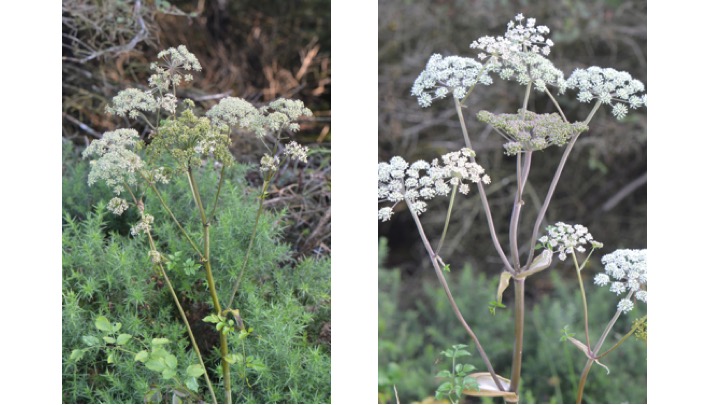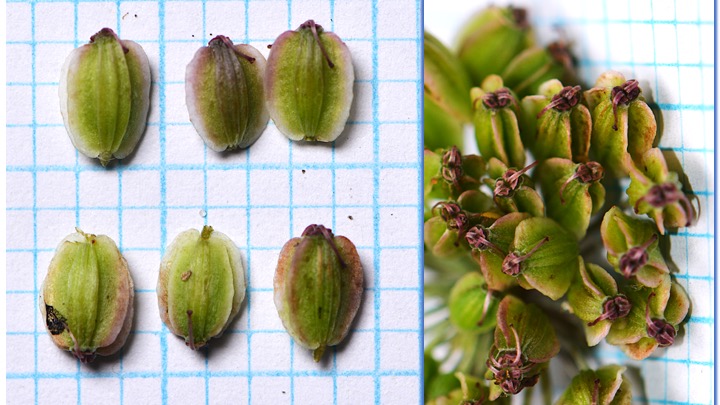by John Grace

“To write a description of that which is so well known to be growing almost in every garden, I suppose is altogether needless; yet for its virtue it is of admirable use”. Thus spake Nicholas Culpeper in his 1653 Complete Herbal. These days, Angelica sylvestris is no longer grown in every garden, yet it has been recorded in the wild throughout the British Isles and grows readily in most soils. It is native in Great Britain, most parts of Europe and much of Asia; it grows as an alien elsewhere, including Canada and New Zealand.
It is a member of the Apiaceae (formerly the Umbelliferae), the family of carrots, parsnips, celery and coriander. They look much the same when in flower, with an umbrella-like structure of radiating pedicels (‘main umbel’), each bearing much smaller umbels (‘umbelettes’) wherein each secondary pedicel supports a small flower. Usually there is a substantial tap-root that stores carbohydrates in the first year; the plant then uses this reserve for rapid development of fresh leaves and flowering stems in the second year (but it often takes longer). It is a large family, having 48 British genera: Stace (2019) thinks there are too many genera, and points a finger at Angelica as one of those that should be combined. The problem of too many genera in some families was considered earlier by Cambridge botanist Max Walters (1961). In the Apiaceae, the excessive number of genera may have resulted from the numerous vernacular names having been given in the mediaeval period. Closely related taxa had distinct culinary or medicinal uses and needed names. Later, these many names were Latinised by botanists. Consider the close similarity between carrot Daucus and the parsnip Pastinaca – shouldn’t they be in the same genus? And perhaps Heracleum should be included. Arguably, based on chemotaxonomic, cytogenetic and structural similarity there should be just a small handful of large genera in the Apiaceae.
In Angelica the flowers are quite small, usually white but sometimes pinkish, purple or even maroon. They are numerous, packed together over the large dome-like surface of the umbels. The main umbels are borne on stalks that are up to two metres tall and conspicuous from far away. The plants are protandrous (the flowers release male pollen before the female stigma is receptive) at the level of both the individual flower and the inflorescence, a feature that encourages outcrossing. These bright and somewhat perfumed flowers attract many large pollinating insects: flies, wasps, beetles and bees; however, Zych et al. (2019) argue that the range of pollinators in members of the Apiaceae is not as large as one might suppose and that there is some degree of specialism in the floral structures. After seed-set in the primary umbels, flowers on secondary umbels take their turn to open thus extending the flowering season over many weeks (July to September). The whole plant dies after the seeds have ripened but the dead stem with its umbels remains over winter. Seeds are scattered only a short distance but they do float in water and skid across ice and snow. For germination success they benefit from a winter chilling treatment, although Lovett-Doust & Lovett-Doust (1982) show that some germination does occur with no chilling. The seeds normally germinate the following spring.

The plant is almost glabrous, and the lower leaves look quite glossy as a result. Leaves are less dissected than many of the Apiaceae, the lower are 3-pinnate, the upper usually 2-pinnate. The stem is hollow, usually green, tinged with purple. The upper leaves have an inflated petiole that protects the stem during development.
As well as the Wild Angelica there is also the Garden Angelica Angelica archangelica, which is native in northern parts of Europe, and can be purchased as seed in Great Britain. It is recorded in the wild on river-banks and waste places in many parts of the British Isles, especially in the London area but sometimes in Scotland. It has flowers that are greenish instead of white, stems that are green instead of purplish, and fruits with a diameter of 6 mm instead of 4-5 mm (Tutin 1980). The two species do not hybridise, despite being very similar with the same number of chromosomes (2n=22, Vasil’eva & Pimenov 1991). Elsewhere in Eurasia there are many more Angelica species – over 100, but hybridisation is almost unknown.

Angelica sylvestris prefers damp conditions, either in light shade or in the open. Its Ellenberg Moisture Value is 8, putting it on par with Cardamine pratensis, Phalaris arundinacea and Schoenus nigricans. The specific name sylvestris means ‘of the forest’ but the species is found in many habitats in addition to wet forests and woodlands. Perhaps the most common habitats are wet grassy places, but it also occurs on road verges especially in wetter western parts of the country, and by rivers and wetlands. It occurs in Scottish mountains: in the Breadalbane range it is a component of ‘hydrophilous tall herb fringe communities’ on ledges of calcareous schist. It is less common in the dry south-east of the country and rarely seen in urban environments. It is a Constant Species in several National Vegetation Types: MG2 Arrhenatherum-Filipendula tall herb grassland; U17 Luzula sylvatica-Geum rivale tall-herb community and W3 Salix pentandra-Carex rostrata woodland. We seldom find it in our own survey of the urban flora of Scotland: it ranks at a frequency of only 275th of the 1,503 species recorded so far.
Its botanical name Angelica sylvestris is misleading, as it more often found growing in the open rather than in woodlands. The story goes that the plant was revealed to the 14th Century physician Mattheus Sylvaticus by the archangel Michael as a medicinal plant. Swedish botanist Carl Linnaeus must have known the story when he named A. archangelica and A sylvestris.
In Canada, Angelica sylvestris is listed as an Invasive Alien. It has spread rapidly along the Saint John River Valley in New Brunswick and threatens Quebec and Ontario.

aid wind dispersal. The squares are 1 mm. Photo: John Grace
Most members of the Apiaceae are aromatic and strong-tasting, related to their distinctive biochemical constituents. Large surveys carried out in the late 1960s showed that almost all contained the sugars apiose and umbelliferose, as well as coumarin compounds such as furanocoumarin, psoralen and angelicin. This biochemical similarity is part of the strong evidence that the family is indeed a natural grouping (eg Crowden, Harbourne and Heywood, 1969). The coumarin compounds that bind with DNA in the presence of ultraviolet radiation cause the well-known phyto-photo-dermatitis, particularly in Amni and Heracleum but also, to a lesser extent in most Apiaceae including Angelica. The compounds are also mutagenic. The strong taste and aroma of these plants is presumably the origin of their use in traditional medicine.
The medical uses of Angelica described in Culpeper’s Complete Herbal will be ignored by the modern reader – many of the remedies seem not just ineffectual but also dangerous. However, Angelica (particularly root material) is still sold for medicinal use. Products can be purchased on-line, for example through Amazon.co.uk. Traditional uses in other parts of the world are common: the Sami people in northern Fennoscandia have always used A. archangelica for medicine and food; another species, Angelica sinensis (dong quai) is important in Chinese medicine.
The use of Angelica by the Sami, and the management of the plants as a resource, is described in detail by Rautio et al. (2016). She describes how plants would be harvested before maturity so that each individual plant would live beyond the normal two-year life span.
The Sami also use Angelica stem to make the fadno, a traditional musical instrument.
The culinary uses of Angelica are diverse. It can be used in salads, or boiled with rhubarb. Its seeds can be used to add flavour to dishes. It decorates desserts as ‘candied Angelica’ which is made by boiling stems in sugar syrup; see for example https://www.bbc.co.uk/food/angelica.
Beware of its highly poisonous relatives. The first is Hemlock Conium maculatum, with its highly divided leaves and purple-spotted stem. It is fairly common and rarely recognised by local authorities who ought to control it more. The second is Hemlock Water Dropwort (Oenanthe crocata), said to be the most poisonous indigenous plant in Britain, common in the west of Scotland by rivers, in ditches and by the coast. Leaves look like celery leaves, stem is green and ridged. See https://www.youtube.com/watch?v=vBRFF-W4Lvk. To the beginner, many of the Apiaceae look similar, so take care when foraging.
The most important use of Angelica these days may be in the manufacture of specialist gin, where it is one of the ‘secret’ botanicals (along with Juniper berries of course) added to give the product its distinctive flavour. If I were Swedish, I might say that the important use is in the manufacture of Swedish Bitters.
References
Crowdon RK, Harborne JB & Heywood VH (1969) Chemosystematics of the Umbelliferae: General Survey. Phytochemistry 8, 1983-1984.
Lovett-Doust & Lovett-Doust (1982) Life-history patterns in British Umbelliferae: A Review. Botanical Journal of the Linnean Society 85, 179-194.
Rautio R, Linkowski WA & Ostlund L (2016) They followed the power of the plant: historical Sami harvest and traditional ecological knowledge of Angelica archangelica in northern Fennoscandia. Journal of Ethnobiology 36, 617–636.
Stace CA (2019) New Flora of the British Isles. 4th Edition. C&M Floristics.
Tutin TG (1980) Umbellifers of the British Isles. Botanical Society of the British Isles.
Vasil’eva MG & Pimenov MG (1991) Karytaxonomical analysis in the genus Angelica (Umbelliferae). Plant Systematics and Evolution 177, 117-138.
Walters SM (1961) The shaping of angiosperm taxonomy. New Phytologist, 60: 70-84.
Zych M et al. (2019) Spatiotemporal variation in the pollination systems of a supergeneralist plant: is Angelica sylvestris (Apiaceae) locally adapted to its most effective pollinators? Annals of Botany 123, 415-428.


One thought on “Plant of the Week – 17th August – Wild Angelica (Angelica sylvestris)”